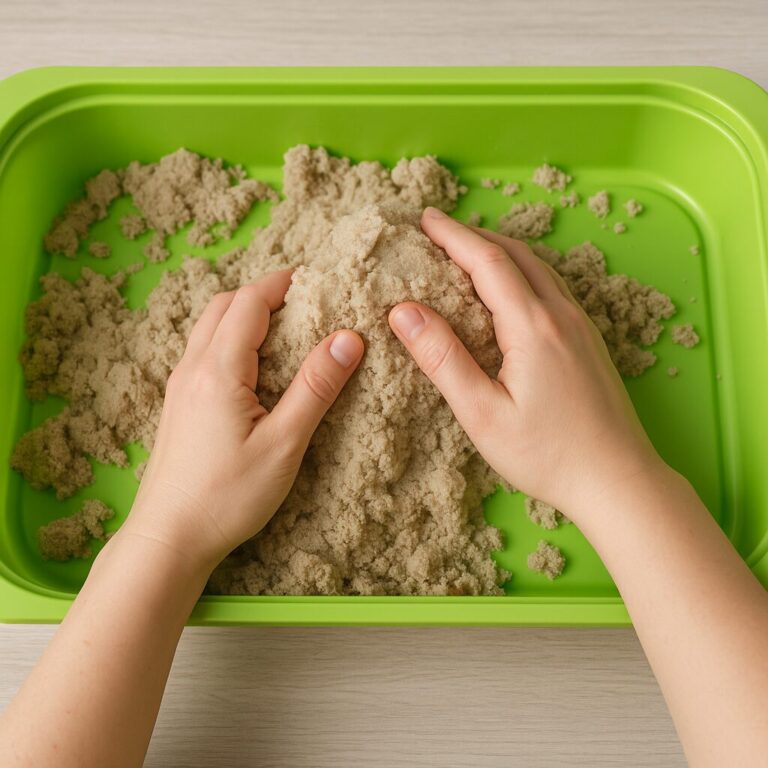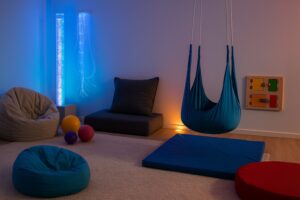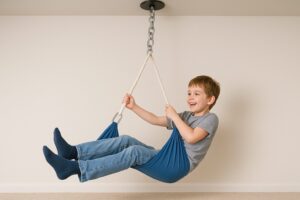Love sensory sand, but not the cleanup? We’ve got you covered.
Sensory sand (like kinetic sand or moldable play sand) offers incredible tactile and calming benefits—but it can get messy fast. With the right setup and strategies, you can create an enjoyable, low-mess experience whether you’re at home, in a classroom, or in therapy.
🧠 Why Use Sensory Sand?
- Regulation & Focus: Molding, squeezing, and flattening sand supports calm attention.
- Fine Motor Skill Building: Encourages hand strength, coordination, and creative manipulation.
- Open-Ended Play: Build, sculpt, and explore with zero rules or screens.
- Portable & Reusable: Great for bins, trays, or even on-the-go kits.
🧼 Mess-Minimizing Tips
1. Use a Sensory Tray or Bin
Contain the sand inside a plastic storage bin, large baking tray, or shallow tub with high sides. This keeps hands busy and sand contained.
2. Lay Down a Clean Play Surface
- Use a plastic tablecloth, towel, or silicone mat underneath the workspace
- Contain mess to one easy-to-clean area
- For classrooms or therapy, designate a sensory sand station
3. Try Smaller Portions
Kids don’t need a whole tub to enjoy it. Offer a handful in a tray or cup for focused, low-mess engagement.
4. Choose Tools That Keep Hands Clean
- Mini rakes, rolling pins, and molds add variety and limit over-handling
- Try using gloves or scoopers if users are tactile-sensitive
5. Store It Right
Keep sand in a zippered bag, lidded container, or storage box after each use. Add a silica gel packet to reduce moisture.
🛒 Our Favorite Low-Mess Sensory Sand Picks
🌟 Kinetic Sand Sensory Bin Kit
Includes pre-filled tray with sand, scoopers, and molds—perfect for travel or tabletop use.
🧠 Moldable Natural Sand Set
Allergen-free play sand that’s easy to shape and doesn’t stick to hands or clothes.
🚀 Sensory Sand & Tools Bundle
Complete kit with mini molds, a folding tray, and sand storage bag—great for home or therapy use.
🏡 Indoor vs. Outdoor Use
| Indoor | Outdoor |
|---|---|
| Use trays, towels, or sensory tables to contain sand | Great for free play, larger scoops, and dumping activities |
| Ideal for classrooms, therapy rooms, or playrooms | Minimize cleanup worries—sweep or hose off areas afterward |
| Pair with sensory bottles or fidget tools for focused stations | Add water play or natural materials like leaves and rocks |
🔗 Related Resources on SensoryGift.com
- Best Sensory Sand Picks & Benefits
- How to Make a DIY Sensory Bin at Home
- Try Our Sensory Toy Finder Quiz
❓ FAQ: Sensory Sand & Mess-Free Play
Is sensory sand safe for toddlers?
Yes, but always supervise. Choose non-toxic, kid-safe sand and avoid small molds that could pose a choking hazard.
How do I clean it off clothes or floors?
Let it dry and brush off, or vacuum loose particles. Kinetic sand typically doesn’t stick to skin or surfaces.
What’s the best container for indoor use?
A plastic bin with high sides or a sensory tray with a lip works best. Consider a lid for storage and portability.
💬 Final Tip
Don’t let the mess scare you off—sensory sand can be incredibly calming, rewarding, and even meditative with the right setup. Use the tips above to make sensory play enjoyable and stress-free for everyone involved.
As an Amazon Associate, SensoryGift.com earns from qualifying purchases. Thanks for supporting accessible sensory tools!


